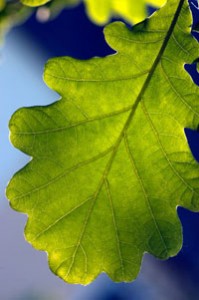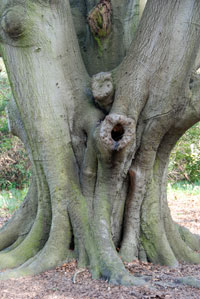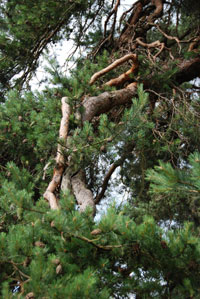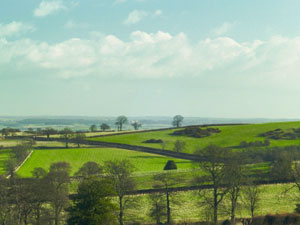Woodlands are more than just collections of trees

A leaf usually has a lifetime of only a single year but is often seen as the basic building-block of a forest which lasts for much, much longer. A tree has a lifetime of about 100 times as long as a leaf, with a lifespan of about 100 years. Looking on a larger scale, the forest may have a life of 10,000 years or about 100 times that of the individual tree. So these three elements – leaves, trees and forests – are each a couple of orders of magnitude apart in their length of life, yet they are vitally reliant on each other, and we instinctively think of a causal chain, with leaves leading to trees and trees leading to forests.
The tree needs the forest more than the forest needs the tree
 However, the question arises as to whether we have got this the right way round. The conventional view was that a forest is made up of thousands of trees and that the forest depends on the trees, but some more recent thinking reverses this and suggests that the tree depends more on the forest: the tree needs the forest to originate the seed from which it grows, to create the ecosystem which nourishes it and to create the protective cloak within which it can survive. This may shed some light on how we can best create, protect or even change our forests – should we be looking at changing the trees or be thinking in terms of whole-forest changes?
However, the question arises as to whether we have got this the right way round. The conventional view was that a forest is made up of thousands of trees and that the forest depends on the trees, but some more recent thinking reverses this and suggests that the tree depends more on the forest: the tree needs the forest to originate the seed from which it grows, to create the ecosystem which nourishes it and to create the protective cloak within which it can survive. This may shed some light on how we can best create, protect or even change our forests – should we be looking at changing the trees or be thinking in terms of whole-forest changes?
National forest: creation or adoption?
Efforts in the last couple of decades to create new national forests (understood as protected areas with a good proportion of trees but also many clear areas) have had mixed success. Some initiatives have been criticised as if they are mostly re-badging wooded areas and announcing how many trees there are and what acreage of forest there is in these areas, rather than nurturing the complex ecosystems that sustain healthy forests.
Forests fight back against the cult of the conifer
This way of thinking, forests over trees, may well explain why it is so difficult to change the nature of a woodland – it's not just a question of felling a few thousand trees and planting up different species.  In dozens of deciduous woodlands we have seen that the coniferisations of the 1960s and 1970s are not in fact forest-changing: the original species thankfully continue to pop up as "weeds"and as edge species. The dominant idea in the post-war years that plantations should be created on ancient woodland was always an environmental disaster, and this is the area where some of the most important conservation work is currently being done in UK woodlands. Indeed, our researches into what woodland owners are doing suggests that many owners of small woodlands understand this very well and are doing it in their woods.
In dozens of deciduous woodlands we have seen that the coniferisations of the 1960s and 1970s are not in fact forest-changing: the original species thankfully continue to pop up as "weeds"and as edge species. The dominant idea in the post-war years that plantations should be created on ancient woodland was always an environmental disaster, and this is the area where some of the most important conservation work is currently being done in UK woodlands. Indeed, our researches into what woodland owners are doing suggests that many owners of small woodlands understand this very well and are doing it in their woods.
Woodlands are much more than just collections of trees......
Treating the forest as the dominant story rather than just thinking about the trees also leads to concerns about the recent drive by some organisations to plant more trees in the UK willy-nilly. It may well be that a better objective would be to extend existing forests.  Where a new forest is wanted, it needs to be more than just trees in fields. There have been experiments with taking rolls of forest floor and transplanting them as part of woodlands creation (a sort of giant skin graft), but this approach has not been widely adopted.
Where a new forest is wanted, it needs to be more than just trees in fields. There have been experiments with taking rolls of forest floor and transplanting them as part of woodlands creation (a sort of giant skin graft), but this approach has not been widely adopted.
Perhaps the problem lies in our perceptions: for as long as most humans perceive a bunch of trees as being a woodland we won't be motivated to try to recreate the other elements of the ecosystem that make a real forest, if indeed such re-creation is even possible over short periods.
Comments are closed for this post.
